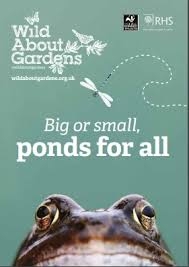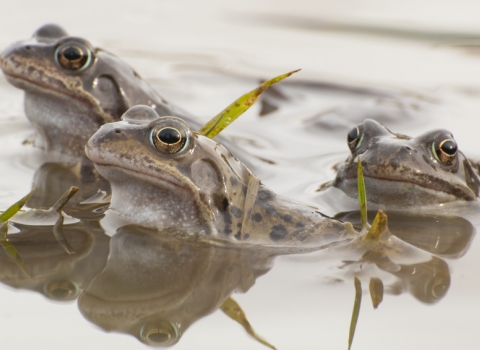Wildlife ponds
Almost 70% of the UK’s natural ponds have now been lost and species such as dragonflies, waterbugs and the great crested newt have declined rapidly over the last 40 years.
A garden pond can provide a home for many species and is one of the best features for attracting new wildlife to the garden including hedgehogs, birds and other creatures that need a fresh drinking source.
Building a wildlife pond
A well designed wildlife pond is great for nature, as well as being an attractive garden feature.
Choose your site
Chose a relatively sunny spot though some shade is good. You don’t want your pond water to get too warm.
Don’t put it too close to trees as rotting leaves in the pond will reduce the amount of oxygen available for wildlife.
It’s a good idea to create other wildlife habitat nearby, such as a meadow and a marshy area.
A small area of paving for viewing or stepping stones are handy, but it’s better to have more natural vegetation along most of the pond edge.
Dig your pond away from services such as underground gas and electricity lines.
Mark out the pond
Ponds can be dug at any time of the year but remember it’s a lot easier when the soil is wetter and softer.
Mark out your pond with a rope, the finished pond will look about two-thirds the size. If time allows, leave it marked out for a few days before digging to check it’s in a good location.
Try to make the pond as large as the space permits. Dig out the marked area creating shelves and ledges of varying depths, 20-30cm depth is good for many plants. It’s a good idea to have a shallow sloping beach at one end of the pond for wildlife to get in and out. Rocks both inside and along the edges of the pond add interest and valuable habitat. Frogs and newts and will swim there for cover, especially to keep out of reach of herons!
Keep the turf for edging the pond later.
Check your levels with a spirit level on a straight edge and make adjustments – you need to get the levels right at this stage. Try and make your pond between 60-90cm in the deepest part. But there is no minimum depth for wildlife ponds. Shallow water makes very good habitat so an extensive pond that is no more than 1.5ft or 50cm deep is fine
Dig the hole about 10cm deeper than the finished depth to allow for the liner and a protective layer of sand.
How to line a pond
- Compact the soil and remove stones which may cause punctures.
- Cover the hole with a layer of sand 5-10cm deep.
- Place the liners (butyl rubber or similar strong, flexible liner) over the hole and position centrally. Gently put them in place.
- Cover the liners with a thin layer of sub soil or sand to allow plants to take root.
- Place a number of irregular shaped rocks in the pond, this will create nooks and crannies for pond-life.
- Make a shallower area with rocks at one end – the ‘beach’.
- Fill the pond with water. Whilst tap water is the most practical source, rain water is much more beneficial (leave the pond to fill or collect from a water butt).
- When full, secure the liner in a shallow ‘trench’ with soil. Trim the liner and edge with the turf you saved from digging the pond. You can buy wildflower turf and put around part of your pond.
- Plant some marginal and tall plants at one end of the pond so wildlife gets a chance.
- You may want to put some stepping stones around part of your pond and you can lay these on a bed of sand.
To work out the amount of liner you will need, use this formula:
Length = greatest length of finished pool + twice the maximum depth.
Width = Greatest width of finished pool + twice maximum depth.
Finishing off the pond
Fill slowly – let the water push the liner into place. Once the pond is full cut off the liner about 50cm away from the top level. Cover with soil, grass turf you kept, wildflower turf or stones. Make a log pile or stone pile nearby as shelter for amphibians.
The pond will look murky for a while but it will settle. You may get an algal bloom “green water” during this period. Don’t panic - once the plants establish this will disappear.
Planting the pond
Allow the sediments to settle for a few days until the water is clear before planting. Often there will be a bit of an algal bloom (‘green water’) at first but this will clear after a week or two. Adding water-fleas (Daphnia) will help as these eat the tiny floating algae that cause this.
You don’t need to plant things in containers and the pond will look more natural if you plant straight into the substrate.
Underwater plants
A good range of underwater plants provides structure and shelter for many pond creatures. Contrary to popular belief you don’t need plants to ‘oxygenate’ your pond, but an underwater jungle supports lots of biodiversity. 'Oxygenators' or underwater plants only play a small part in oxygenating the water – the wind will do that. But they do provide shade and cover for wildlife.
- Rigid hornwort Ceratophyllum demersum
- Spiked Water milfoil Myriophyllum spicatum
- Alternate Water milfoil Myriophyllum alternifolium
- Pondweeds: Potamogeton alpinus, lucens, perfoliatus, gramineus. These plants have very beautiful semi-transparent leaves and form a nice open canopy. They need to be able to run around the bottom of the pond and do not do well in containers. Grow them from pieces of root weighted down with a small stone. P. gramineus and alpinus produce a few floating leaves.
- Water crowfoot Ranunculus aquatilis (there are lots of related species that are quite similar).
- Water starwort Callitriche stagnalis or Callotriche hamulata (likes muddy shores).
- Utricularia (interesting and if you are lucky you will get pretty little yellow flowers).
- Stoneworts such as Chara (C. virgata is the easiest but if you have lime-rich water some of the other species are worth a try).
- Nitella spp.
- Pillwort which is very easy.
Floating plants
- Amphibious bistort Persicaria amphibia
- Frogbit Hydrocharis morsus-ranae
- Floating sweet-grass Glyceria fluitans (may get invasive and needs controlling)
- Garden Water-lily Nympheae hardy hybrids – chose once that don’t grow too big
- Water soldier Stratiotes aloides (not native to Wales, but not invasive in North Wales)
Avoid duck weeds (Lemna species) as they can invade your pond if left unchecked.
Shallow water emergent plants
- Water forget-me-not Myosotis scorpioides
- Lesser spearwort Ranunculus flammula
- Spearwort Ranunculus lingua
- Arrowhead Sagittaria sagittifolia
- Brooklime Veronica beccabunga
- Bogbean Menyanthes trifoliatea
Tall emergent plants
- Flowering rush Butomus umbellatus
- Water mint Mentha aquatica
- Water plantain Alisma plantago-aquatica
Marginal plants along pond edge
- Bugle Ajuga repens
- Marsh marigold Caltha palustris
- Hard rush Juncus inflexus
- Lady’s smock Cardamine pratensis
- Yellow flag Iris pseudacorus
- Ragged-robin Lychnis flos-cuculi
- Purple-loosestrife Lythrum salicaria
- Marsh woundwort Stachys palustris
- Water forget-me-not –Myosotis scorpioides
Plants to avoid
These plants are banned from sale in the UK and you must not put them in your pond as they are invasive and cause serious problems in our natural water courses costing millions of pounds to clear.
- New Zealand Pigmyweed or Australian Swamp-stonecrop – Crassula helmsii
- Water or Fairy fern - Azolla filiculoides
- Parrot’s-feather - N.B. sold under a number of other names too, including: Myriophyllum aquaticum, Brazilian Water-milfoil Myriophyllum brasiliense, Myriophyllum proserpinacoides,
- Canadian pond weed Elodea canadensis
- Nuttal’s waterweed – Elodea nuttilii
- Curly waterweed - Elodea densa/ Lagarosiphon major
- Floating pennywort .NB. May also be sold as Water Pennywort - Hydrocotyle ranunculoides
- New Zealand pennywort - Hydrocotyle novae-zeelandiae
- Water primrose - Ludwigia grandiflora, L. hexapetala N.B. May also be sold as Jussiaea grandiflora or Ludwigia uruguayensis
- Water hyacinth - Eichhornia crassipes
- Water lettuce- Pistia stratiotes
- American skunk cabbage - Lysichiton americanus
- Fringed water-lily Nymphoides peltata
- Avoid duck weed if possible as it shades other things out.
Maintenance
- Best time to do maintenance work is late October/early November. Avoid working in the pond between February and October, as life will be active and breeding.
- After a few years the plants will become overgrown, therefore remove a third of underwater and fringe plants.
- Leave the plants by the edge for a few days, then compost.
- Keep removing plants every year to avoid your pond filling in.
- There is no need to introduce barley straw to control algae if you have an intermittent problem. It’s better to look for possible sources of nutrients.
- You don’t need to have water lilies and you certainly don’t need to have 40% shading by lily pads to keep algae under control.

Download your guide to building a pond
Adding a pond is one of the best things you can do for wildlife in the garden. And each pond is part of a bigger picture – together we can create a network of habitats for our threatened freshwater species, and the many insects, birds and mammals that depend on them.

